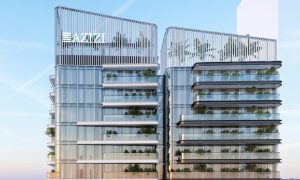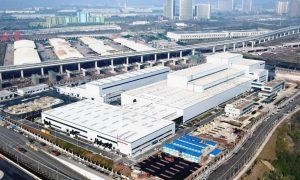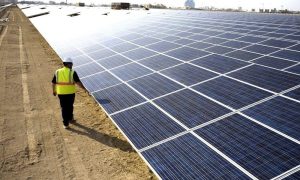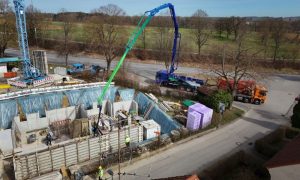Zeroing in on Net Zero
Jason Saundalkar talks to four regional experts about the region’s journey towards net zero, the challenges that have to be overcome and the solutions that could have a pronounced impact

Climate change, due to global warming, is an existential threat to our way of life. Today, even a cursory glance of news sources or social media feeds is bound to reveal disasters such as draught, hurricanes, storms/storm surges, and wildfires, all of which are occurring with increasing frequency and intensity.
The 2016 Paris Agreement sought to take on climate change by ensuring that action was taken to limit global warming to well below two-degrees Celsius, but preferably to 1.5-degrees Celsius, compared to pre-industrial levels. To achieve this goal, countries must aim to reach the peak of greenhouse gas emissions as soon as possible, so they can achieve a climate neutral world by mid-century.
As the built environment is responsible for an estimated 40% of global carbon emissions, it’s vital for the sector to do its part in support of the push to limit global warming. The good news is there are many ways the sector can reduce its impact on the environment including developing new structures or retrofitting older ones so they achieve net zero status.
Commenting on where key the key GCC markets of the UAE and Saudi Arabia are in terms of their respective journeys to net zero buildings, Engi Jaber, managing director, Climatize Engineering Consultants explains, “While the topic of net zero was brought forward recently within the GCC markets, we’ve witnessed an exponential growth in awareness, dedication and projects since then, especially those driven by the governments. Solar farms, hydrogen plants, and other measures are being installed at large scale.”
“However, results are still far off, some cities are way behind, others are lacking the infrastructure or necessary actions in the matter, and we find developers and owners not willing to join the drive unless a mandate is in place, as part of the built environment codes and permitting. Considering the commitments made towards achieving zero energy by 2050 in the UAE and 2060 in KSA, both the public and private sectors will need to push forward and gain momentum on the topic urgently, the latter more so.”
Farah Naz, lead of specialist services, sustainable ESG solutions, AECOM Middle East and Africa adds, “Leaders in the UAE and the KSA recognise that climate change could lead to a four-degree temperature increase by around 2050, resulting in potential destabilisation of regional food, water and fuel security. This realisation has increased the urgency among the UAE and KSA’s government to place themselves on an environmentally resilient pathway through investment in renewable energy, dedicating government resources to develop councils that seeks solutions to climate change and thus implementing targets to net-zero emissions.”
“The transition to net zero building will require policy changes to reduce embodied and operational carbon emissions in addition to generating renewable energy to power the assets. Concrete is a key enabler for this transition both for its own decarbonisation and for reducing emissions in the built environment. As the industry has already committed to drive innovation for low carbon products, the success for this approach is highly dependent on regulatory and standardization frameworks leading to increase in the market demand.”
The region is essentially waking up towards a net zero transition but getting to net-zero is politically challenging just as it is socially, economically and structurally challenging, she says.
Lindsey Malcolm, associate Sustainability director, AESG notes, “It’s exciting to see that both the UAE and KSA have announced net zero policies and strategy, with targets for 2050 and 2060 respectively. The significance of recognition at the highest levels of government around the importance of achieving net zero for the built environment cannot be understated. The aspirations of regional government, coupled with increasing numbers of multi-nationals with strategic net zero plans in place, will really help drive the focus and action in the market. It is clear from the findings of the latest IPCC report that significant action needs to be taken and that it needs to happen faster than it currently is, in order for us to secure a healthier, cleaner planet. This urgent action applies to all of us within the industry, particularly given the immense potential impact that we can have on the strong pipeline of development that is going to happen in the next five to ten years.”
Samar Hussein, associate, senior architect, co-leader for design resilience in the APME, Gensler Middle East remarks, “GCC cities are some of the most vulnerable, globally to the impact of climate change, to sea level rise and extreme heat waves, which has the potential to impact livelihood in these cities. I think traction is happening in the building industry, but the pace needs to be more aggressive and consistent. Limited successful case studies will not be sufficient to move the needle.”
“Developers need to understand the impact of current decisions made on their building longevity and compatibility with a net zero world in the near future. Professionals across the construction industry need to work more collaboratively across disciplines, so that project targets are well planned and executed.”
Surmountable Obstacles
Discussing some of the challenges in terms of the march towards net zero structures in the GCC’s two key markets, Naz states, “This biggest challenge for any city in the UAE or Saudi Arabia is to establish and understand the carbon emissions from the key sectors including transportation, utilities, energy, agricultural land, forestry and fishing, construction and materials. This is extremely important to establish a comprehensive roadmap towards a net zero transition. General market maturity to meet these transitions is one of the biggest challenges in the region, as well as globally.”
“With the requisite knowledge in hand, the second challenge is establishing a comprehensive policy and action plan towards a Net Zero Transition Action Plan, through policy, implementation, monitoring and evaluation programs, pilot studies and investments. Third, you have to establish industry wide knowledge, awareness and incentive programs to drive this transition.”
She adds, “The ‘three Ds’ that will increase the efficiency of this transition are diversity, decarbonisation and digitalisation. With regards to diversity, the contribution of GCC nationals towards net zero change can be largely driven through younger generations. The demographics of the utility system can be utilised efficiently through various schemes to decrease unemployment rates and gender differences.”
“With decarbonisation you have to establish a systemic way to understand the vision of the organisation, city or country before developing a roadmap with set priorities and targets. And when it comes to digitalisation, establish awareness through enhancement of the citizen’s experience, so that the machine -learning behind these complex systems can render beneficial simple solutions to the users.”
Malcolm notes the biggest challenge is market understanding around net zero and what it actually means. He comments, “There is a wealth of information in the market but there is not always a clear consensus. We regularly have conversations with clients about what net zero means to them and how it can be implemented on their project or across their portfolio and operations. Further to this, the ability to accurately assess embodied carbon in construction and the ability to drive decision-making based on lifecycle carbon impacts are the other big challenges the industry faces. For the former, the lack of locally attuned data makes assessment of material impacts from cradle-to-site a major challenge.”
“On top of this, the market has not yet fully matured in relation to materials management, especially around recycling and circular economy. This lack of accurate, locally relevant data for embodied carbon, coupled with the complexity in the conventional methods of assessing operational carbon (and energy), mean that often in the early stages of projects when key decisions are being made, they are done so without a full understanding of the lifecycle carbon impacts.”
“To address these challenges, we are collaborating with the industry to foster standardisation of net zero definitions and targets. We’re also working closely with businesses across the supply chain to identify gaps in performance measurement and to explore new approaches. Industry collaboration is key to standardising net zero carbon definitions and targets, as well as providing clarity to the wider supply chain needed to stimulate the provision of innovative technologies to support decarbonisation efforts.”
Jaber notes, “Cost is one of the main challenges. Investors/ developers not willing to absorb additional costs associated with the needed amount of renewables to offset the remainder of the energy demand. The design team not ‘designing’ with efficiency in mind from early stages and the lack of net-metering regulations and incentives are also ongoing issues.”
Hussein states, “The speed at which buildings are designed and constructed takes a toll on long term planning required for net zero buildings. I think one of the main challenges for net zero buildings in the region is also the reliance on fossil fuels as the main source of energy for operating buildings. Couple that with the harsh and arid climate conditions which increases cooling requirements and buildings, by default, consume more energy in the region. HVAC systems are estimated to account for more than 75% of building energy use here.”
She adds, “The regions aspirations for iconic and super high-rise structures, results in higher utilisation of concrete, steel and aluminum. These three materials are responsible for 23% of global emissions. Cement alone accounts for 8% of CO2 emissions globally.”
Tackling Embodied and Operational Carbon
To develop net zero buildings, embodied carbon and operational carbon must be tackled effectively. However, since embodied carbon covers GHG emissions from the energy and industrial processes used to manufacture and deliver construction materials, can construction stakeholders actually address the embodied carbon challenge effectively and on a broad scale?
Hussein responds, “Embodied carbon research and understanding is growing internationally. In fact, Gensler is engaged in extensive research on quantifying embodied carbon in buildings, where we identify the key interior and building scale products to focus on to reduce embodied carbon.”
“One of the best ways to optimise embodied carbon is to start advocating for more building adaptation and retrofitting, instead of building new. It is estimated that by using existing building structures, there is the potential of reducing environmental impact by 46%, in comparison to new building construction. The same can be addressed in interiors by salvaging and reusing as much as we can. The second strategy is to push our supply chain for more tracking and reliable data for all materials ordered, with a focus the ones that have the biggest impact and are used in the biggest volumes.”
“Last year, Gensler deepened its commitment to combat the impact on climate change in the built environment and its challenge to the entire design industry — to meet an ambitious goal: the elimination of all greenhouse gases associated with the built environment. We have challenged all designers, architects, developers and anyone in a position to influence the built environment, to join our mission. We ask that the entire building sector join us in making sure our future is everyone’s future.”
Malcolm points out it is possible, explaining, “Through understanding what the GHG emissions are at each stage of the process, seeking answers where information is lacking, comparing alternative options, pushing back on manufacturers and suppliers where inefficiencies are present, requesting better options and approaches, construction stakeholders can drive change. This action can and should be taken en masse, led through industry groups and collectives to drive change. This is already happening to an extent, through working groups, industry bodies and other collectives; with increasing dialogue at events about how we can better measure the impacts and better effect change.”
Jaber adds, “Yes, via taking the challenge on to research and select low carbon materials from the get-go and request all the product reports and declarations ahead of the construction phase to ensure its performance. By doing so, industry stakeholders would ultimately drive the supply chain onto utilising alternative manufacturing techniques in lieu of fossil fuels and encourage carbon-centric approaches. Moreover, designers can minimise waste and materials by design with efficiency in mind in addition to performing life cycle assessment calculations from concept onwards and utilize the assessment to make informative decisions that has a positive impact and contributions towards decarbonisation.”
“There are multiple stakeholders that will need to play their part if embodied carbon is to be reduced in the sector, but ultimately there needs to be a financial or legal compliance incentive provided by the market or through government legislation. One of the biggest challenges for any city in the UAE or Saudi Arabia is to establish and understand the carbon emissions from the key sectors I mentioned earlier,” Naz remarks.
“The effective way to address embodied carbon in the built environment calls for a number of things: governments to adopt the Climate Change Act; governments to set legally-binding ‘carbon budgets’; undertake a climate risk assessment at the country level; establish a national adaptation programme to address the risks identified in the climate risk assessment,” she outlines.
Highlighting what elements contribute heavily to a building’s operational carbon output and what can be done to enhance a building’s efficiency, Jaber clarifies, “Emissions arise from energy consuming activities including heating, cooling, ventilation and lighting of the building, so called ‘regulated’ emissions under Part L of the Building Regulations, and other, currently ‘unregulated’ emissions, including appliance use and small power plug loads such as IT.”
“We can reduce the operational carbon of heating/ cooling the space by efficiently accounting for low carbon thermal insulation, envelope seals and other envelope efficiency measures. Alternatively, one could look into efficient lighting as well as restricting receptacle and process loads which are major contributors during the operational phase. However, while materials are usually associated with embodied carbon, they also factor into the operational carbon and therefore seeking efficient alternatives in this respect would also facilitate operational reductions. For example, selecting rebars manufactured via electric arc furnace.”
Malcolm comments, “Façade design and performance has probably the greatest impact on buildings’ operational carbon performance, as well as having a not insignificant impact on embodied carbon performance as well. Optimising the façade design to achieve a balance between comfort, views, daylight, materials, and aesthetics is a key opportunity area. Within AESG our Façades and Sustainability teams work closely together during the initial stages on projects, using smart simulation tools to optimise the performance of the building envelope. This refined design approach allows projects to go beyond the conventional code and standard requirements to achieve the highest levels of performance including the attainment of net zero in a number of cases. As with all aspects of design, the focus on operational carbon is not taken in isolation, but also considering the embodied impacts of the materials and products selected to ensure the best approach from a lifecycle perspective.”
Hussein says one of the best ways to improve a building’s operational carbon is through right sizing and correctly planning the building early on in design.
She says, “It’s estimated that 90% of project impact is determined by early design decisions. Efficient form, planning and maximised space use can significantly reduce operational carbon because essentially you are cooling and lighting less space. Orienting the building facades and fenestration accurately and the utilisation of appropriate forms of shading can both increase your building access to daylight and reduce building cooling loads. Airtight and well insulated building envelopes with controlled operable elements will also optimise the efficiency of building ventilation systems and reduce thermal transmittance.”
Revamping the Supply Chain
Shortening supply chains is cited as an effective way to reduce embodied carbon in construction projects. But considering the appetite for foreign materials in GCC markets and the havoc wreaked upon existing supply chains by the pandemic, is this still a viable option for reducing embodied carbon?
Naz responds, “While it is true that shortening supply chains and sourcing materials as locally as possible reduces embodied carbon, this is only one part of the equation. Specifying low carbon materials, not over-specifying material quantities and sourcing materials from low carbon suppliers are just as important as the length of the supply chain. It is quite possible that importing a material produced sustainably – or within a low carbon energy environment – could be less carbon intensive than using a local material manufactured using carbon-intensive energy. The challenge in GCC markets is availability of data to allow these decisions to be made, as although an increasing number of foreign materials are registering Environmental Product Declarations (EPDs), the lack of corresponding information from regional suppliers means it is hard to say what impact longer supply chains actually have.”
Hussein agrees with Naz with regards to the supply chain being only part of the equation. He says, “Partially, this will help reduce the embodied carbon footprint resulting from materials transportation and will promote an increased use of local materials. However, the main challenge remaining will be to get the local market and supply chain to adopt tracking and transparency on their material sources and carbon footprint, which will require time for maturity with the continuous push and encouragement from the building industry and governments.”
“Design teams would need to weigh up the benefits of highly sustainable materials procured internationally vs. local materials that don’t offer the same carbon value assessments, without compromise to project sustainability. We should always strive for the best of all aspects and look at materials holistically from aesthetic and performance perspectives.”
Jaber asserts, “It’s more viable than ever. The pandemic has in its own way forced the market to rely on existing and regional supply chains and sourcing, where feasible or seek out alternatives. This in essence captures the idea of embedding reductions in carbon emissions in the chain, particularly from sourcing and transportation. The main barrier to relying on regional supply is the availability of certain raw materials but this brings us back to the idea of challenging the design and construction industry to seeking alternatives that are more efficient, reused or recycled and contain lower embodied carbon.”
Malcolm notes that the pandemic highlighted challenges with global supply chains, while recent extreme weather events have further exacerbated issues.
He concludes, “These are challenges we must face as an industry, both in the context of the GCC region but also considering that the impacts we see do not respect national borders. Shortening supply chains can help in reducing carbon footprint, however, it may not be the most sustainable approach when considering the wider impacts and the interconnected nature of our societies. As a business we work globally and the impacts of our work are felt globally. The sharing of ideas, initiatives, materials, products, lessons-learnt and expertise on a global scale will be the best approach to achieve net zero for the built environment. This should be the focus we take.”
This feature first appeared in the May 2022 issue of Middle East Consultant.















